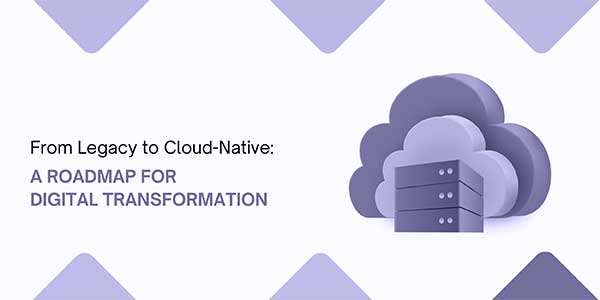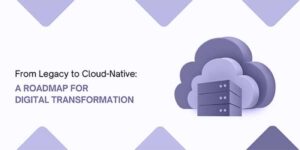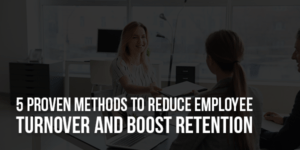
It is difficult to believe how digital 2025 will look compared to a decade ago. Companies in every sector are competing to modernise their IT environments, eschewing the legacy systems that previously underpinned their growth and betting instead on cloud-native architectures, which offer agility, scalability, and resiliency.
For IT leaders, this isn’t up for debate anymore — it’s no longer a question of “if” but rather how fast or effectively to make this shift. This isn’t just a matter of investing in new technology, though that is where it will start – reinventing mindsets and processes, and even entire avenues of business will be needed to survive in a world that puts the cloud first.
In this post, we will delve into the 2025 roadmap for IT leaders on the legacy to cloud-native journey, why embracing this change is critical to sustainable innovation, and why even eCommerce ecosystems like PrestaShop Waiting List and Preorder modules have a hard time leveraging adaptability and customer-centric evolution.
Table of Contents
The Legacy Trap: Why Change Is No Longer Optional:
The legacy system was the lifeblood of the enterprise. They provided a basis for reliability and control, developed over years of perfecting. But in the digital age, they’ve become as much of a hindrance as a help.
These systems often suffer from:
- High cost of maintenance and complex relationship dependencies.
- Stiffness in integrating with newer applications.
- Pace of product change/inflexibility to demands from the market or users.
- Limited scalability for growing workloads.
For IT executives, holding onto these platforms puts you at risk of standing still in a rapidly changing market. A move to cloud-native infrastructure is not simply a matter of technology modernisation — it’s about unleashing speed, resilience, and continuous innovation.
What Is Cloud-Native? It’s More Than Just Migrating To The Cloud:
The concept of “cloud native” is often mistaken for the simple word “cloud migration.” But if migration is about shipping existing systems into the cloud, cloud-native applies to building and designing them from scratch so that you make full use of the cloud’s potential.
Key Characteristics of Cloud-Native Systems:
Microservices Architecture:
Apps are decomposed into smaller, loosely coupled independent services that can be developed, deployed, and scaled individually.
Containerization:
With the help of tools such as Docker or Kubernetes, apps run dependably across environments so that deployment becomes faster and more reliable.
Continuous Integration/Continuous Deployment (CI/CD):
Allows for updating and enhancing the system quickly with minimum downtime.
API-Driven Connectivity:
Encourages smooth connectedness of services and other systems with flexibility and extendibility.
Automation & Observability:
Provisioned with monitoring, built-in automatic scaling, and fault tolerance features.
This method affords businesses the ability to iterate quickly, rolling out new features on a weekly (if not daily) basis – something that would have been inconceivable in the legacy environment.
Why 2025 Is The Tipping Point For Cloud-Native Implementations?
By 2025, cloud-native systems will no longer be the exception in new deployments — and for everything else. According to a recent Gartner report, more than 95% of new digital workloads are expected to be delivered with cloud-native technology within the next few years. Several overlapping trends are driving this change:
The Acceleration of Digital Transformation
The digital acceleration undergone by businesses in the post-pandemic era has forever adjusted the expectations of customers. Faster, more personalised, and always-on experiences are something that businesses must strive to deliver. Cloud native systems offer the flexibility to serve these needs.
Cost Optimisation and Operational Efficiency
Those legacy systems have become virtual budget black holes to operate and maintain. In contrast to all these on-premises (traditional) approaches, cloud-native models provide pay-as-you-go elasticity and minimise infrastructure overheads.
Security and Compliance Evolution
All the security, encryption, and compliance are built into most modern cloud platforms and in many instances, exceed what is available with on-premises systems. This addresses one of the major worries in previous years—trust in the cloud.
AI and Automation Readiness
Cloud-native architectures are inherently AI-friendly. Both support the use of machine learning workflows, predictive analytics, and intelligent automation that could potentially deliver innovation throughout the enterprise.
The IT Leader’s Guide To Transitioning From Legacy To Cloud-Native
Moving to a cloud-native architecture doesn’t happen overnight. It’s a strategic venture that mandates clarity of vision, phased execution, and alignment with the entire organisation. So here’s a workable map for 2025 and beyond:
Step 1: Assess and Audit Your Existing Infrastructure
Before embarking on the cloud journey, IT leaders need to assess where they are today. Perform a thorough infrastructure assessment to determine:
- What systems are vital and need to be re-architected?
- That can be retired or replaced.
- Integration points and dependencies.
This stage assists in determining the workloads for migration and ensures that certain business continuity is not interfered with.
Step 2: Define a Clear Cloud Strategy
Not all clouds are the same. Businesses can opt for either public, private, or hybrid clouds depending on their requirements, budget, and compliance needs.
- Public Cloud (AWS, Google Cloud) – Ideal if you have growing needs and want to save some money.
- Private Cloud: Suitable for businesses that have heavy and/or strict regulatory compliance.
- Hybrid Cloud: Combines the flexibility of both.
The mission: to bring cloud strategy into line with business objectives — and not just IT modernisation.
Step 3: Gradual Modernisation
If the first two steps had a disorientating effect on our enemy, we need to revert to a gradual posture with him in this step.
A gradual transition mitigates risk. IT chiefs should replatform and refactor old applications rather than lifting and shifting them.
Refactoring makes apps take advantage of microservices, containers, and serverless computing to be efficient over the long haul.
Step 4: Cultivate a DevOps Culture
Technology is not enough to lead transformation—we need people and culture just as much.
DevOps helps to bring together the development and operations teams for a more rapid delivery, continuous feedback, and richer innovation. This culture is based on building with automation tools, CI/CD pipelines, and cloud orchestration platforms.
Step 5: Address Security and Governance First
To keep pace with the shift of data and apps to the cloud, IT execs now must enable security natively within the cloud:
- Zero-trust architecture.
- Continuous monitoring and threat detection.
- Automated compliance checks.
A proactive governance strategy prevents that, and they won’t have any scalability haunting them over their risk compliance or data integrity.
Step 6: Educate and Upskill Teams.
The largest barrier in the path to digital transformation is not technology; it’s skill. IT will need to get skilled in cloud, automation tools, AI integration, and DevSecOps.
Lifelong learning of employees means they are becoming more agile, innovative, and future-ready
Step 7: Measure and Optimise
After migration, it is essential to measure your main performance indicators: up time of the system, speed of deployment, efficiency, cost, and customer satisfaction from customers.
This allows IT leaders to pinpoint optimisation opportunities and ensure the transformation is delivering measurable value.

How Does eCommerce Reflect Cloud-Native Agility?
It turns out that eCommerce serves as a quintessential mini-universe to witness the power of cloud native evolution. Solutions such as PrestaShop, for example, have matured well beyond basic e-commerce website builders to become scalable ecosystems that allow businesses to build with customizable building blocks.
Two main modules – PrestaShop Waiting List and Preorder demonstrate how cloud supports systems to become flexible to customer demands, by telling you when they see inflated or deflated orders.
1.) PrestaShop Waiting List: Real-Time Responsiveness
PrestaShop Waiting List Module buyers can register for the email alert to subscribe if your out-of-stock product is available. The moment products are added, triggers can be set to activate alerts via automation.
This capability illustrates two of the cloud-native principles:
- Asynchronous systems for real-time event handling.
- API- and event-triggered communication to scale automatically.
- The Customer-focused Innovations that improve UX with NO manual action.
Such automation and scalability come naturally in a cloud-native environment, showing how companies can continue to serve their customers at any scale.
2.) Preorder: Predictive Commerce for Smarter Demand
Prestashop Preorder allows your customers to purchase products before they are available.
And this isn’t just marketing—it’s a smart, data-driven model that benefits businesses:
- Forecast demand with precision.
- Optimise inventory management.
- Generate early revenue streams.
In a cloud native world, such capabilities can be combined with AI systems to forecast purchasing trends, automate supply chain choices, and customise offers in real time.
So where it started as an eCommerce-only feature, today’s RefundTX morphs into a strategic offering driven by cloud-based real-time intelligence.
Overcoming Common Pitfalls With Cloud-Native Transformation:
The path to cloud-native is not without obstacles. The IT leader has to deal with:
Legacy Mindsets:
Cultural inertia can slow progress. Resolving resistance involves positive evidence delivery and leadership dedication to change.
Skill Gaps:
Upskilling the workforce in cloud, DevOps, and AI-driven monitoring is critical for sustained success.
Integration Complexity:
Most legacy systems are not API enabled, which can pose challenges when trying to integrate. IT organisations need to invest in middleware and API management capabilities for connecting the dots.
Cost Governance:
Cloud promises to lower infrastructure costs, but poor management may result in ‘cloud sprawl’. This is where continuous tracking and honing come into play.
Taking these on proactively gives IT decision makers the confidence to move forward and speed up transformation.
The Business Payoff: The Cloud-Native Way Is the Future:
Here’s the point: Making the switch to cloud-native infrastructure is good for business:
- Speed: Shortened cycles and faster rollouts or updates.
- Scalable: Resources that expand to meet the demands.
- Resilience: Systems that heal themselves with as little downtime as possible.
- Innovation: Fast experimentation with low risk.
- Customer-Inclusive: 1-to-1 interactions driven by the most recent data.
Predictive manufacturing and Preorder automation Cloud native tech that allows businesses to innovate continuously, ranging from predictive analytics in manufacturing to pick up in store for e-commerce.
The 2025 Future Ready Enterprise:
By 2025, IT leaders will no longer be measured by their ability to maintain uptime—they’ll be judged on how well they enable innovation, resilience, and digital growth.
Transformation from legacy to cloud-native is not simply a shift in technology, but rather, it’s a cultural and strategic shift that embodies the modern enterprise.
Businesses that adopt this transformation early and take advantage of modular architectures, AI-enabled services, automated solutions, and a customer-centric work item like PrestaShop Waiting List & Preorder will be the front-runners in digital business.
The path forward is clear: organisations that develop not only in the cloud but for the cloud will thrive.
Conclusion:
The transformation of IT from legacy to cloud-native is the most significant journey of our generation. It requires courage, clarity, and a commitment to building an America that can succeed in 2025 and beyond — one that must change with the times.
IT leaders can future-proof their businesses by adopting cloud- native principles, cultivating agile teams, and laying the groundwork for continuous innovation.
And in the same way that tools such as PrestaShop Waiting List and Preorder are remapping eCommerce agility, other industries likewise have to follow the three tenets of responsiveness, intelligence, and customer-centricity into an era of cloud native.
The road map to 2025 isn’t about getting over the past; it’s about establishing a future where technology and innovation are in sync.

 About the Author:
About the Author:
















Be the first to write a comment.